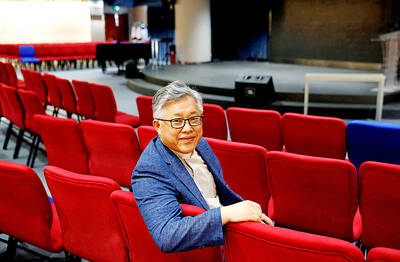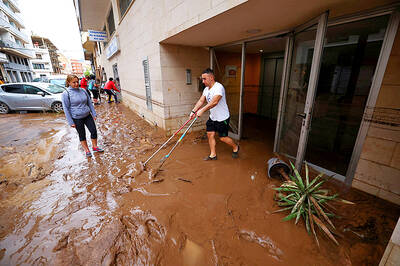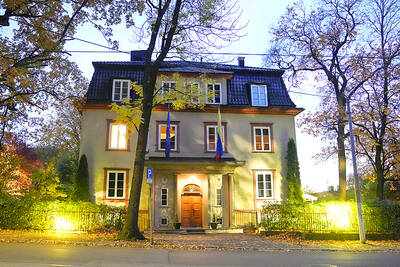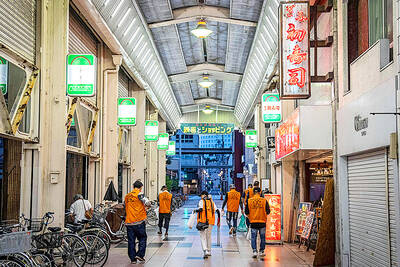Shifting debris and twisted metal by hand, Haitian workers backed by Japanese UN military engineers on Monday rescued remaining valuable paintings and sculptures from the collapsed rubble of one of Haiti’s most notable art museums.
The workers and UN troops were trying to salvage what they could of Haiti’s rich artistic heritage, ravaged by the Jan. 12 earthquake that may have killed up to 300,000 people, the country’s president said.
Port-au-Prince’s Nader Art Museum, which with 12,000 paintings housed probably the world’s most important private collection of Haitian art, was reduced to rubble by the quake, which also badly damaged the presidential palace, the city cathedral and many other historic buildings.
Since the quake struck six weeks ago, gallery staff have been carefully extracting the most important works from the wreckage. Brightly colored canvases, many torn and smeared with dust, are piled to one side, while empty wooden frames are stacked in another pile.
Workers carry away wooden and metal sculptures, some missing arms and legs in a grotesque reflection of the horrific human injuries inflicted by the quake.
Georges Nader Jr, 40, son of museum owner Georges Nader, said the “search and rescue” phase of the museum salvage operation was almost over.
“We’ve been digging for a month ... the hand removal stage is almost over, then heavy machinery will move in,” he said. “But if you put a mechanical digger in there right away, you will lose everything.”
He was philosophical about the loss to the collection.
“I think about 50 percent, with some kind of restoration, will be salvageable,” Nader said.
A separate Nader gallery in Petionville district survived the quake.
About 95 percent of the Haitian masters part of the museum collection, including works by Hector Hyppolite (1894-1948) and Philome Obin (1892-1986), survived because they were housed in a front part of the collapsed building, Nader said.
“Some are not even scratched. We have someone working on restoration, where necessary, right now,” he said.
Asked if the collection was insured,” Nader laughed wryly: “If it was, I wouldn’t be here.”
Of the museum’s sculptures, reflecting the rich African heritage of Haiti, which won independence through an 1804 slave revolt, Nader put losses at between 60 percent and 70 percent.
“When we pulled the sculptures out, some of them had broken arms and legs,” he said.
Japanese UN officers wearing blue caps and helmets and the shoulder patches of Japan’s Central Readiness Regiment, supervised workers and a mechanical digger.
Around 200 Japanese troops are participating in the international relief operation in Haiti, and this number would rise to over 300 next month, Captain Shingo Hayakawa said.
Nader’s father George, 78, who started the collection in 1966, and his mother, both survived the quake.
Nader said he believed much of the Caribbean’s country’s artistic patrimony, including the famed 1950s mural paintings of the Sainte Trinite Cathedral, had been lost.
But amazingly, many of the city’s oldest houses, which are built of wood in the elaborate “gingerbread” Caribbean style, withstood the magnitude 7 quake, while hundreds of more modern concrete, steel and mortar structures crumbled.
“This would a good time to restore the old houses,” Nader said.
France, Haiti’s former colonial master, will draw up a preparatory study for reconstruction of the wrecked presidential palace, and has offered to restore a damaged 1822 painting depicting Haitian independence heroes which was salvaged by a French team from inside the ornate white palace.
In other news, six US-bound orphans seized by Haitian police despite having their papers in order remained in a government-run nursery more than two days later, the orphanage director said.
The seizure of the orphans and the brief detention of their escorts on Saturday came amid fears that foreigners are exploiting the post-quake chaos to illegally take children from the country — a perception fueled by an ongoing case involving 10 US Baptist missionaries.
“The youngest has developed diarrhea and is very dehydrated,” said Jan Bonnema of Prinsburg, Minnesota, founder and director with her husband, Bud, of the Children of The Promise orphanage, where the six children originated.
Bonnema, whose orphanage is located in the northern city of Cap-Haitien, said late on Monday that the children had been bound for the US via Miami, where their adoptive parents were waiting for them.
Police detained the children and the four women escorting them, including the orphanage’s Irish field director and one US adoptive mother, Sarah Thacker of Ferbus Falls, Minnesota, as they were about to depart from Port-au-Prince airport on Saturday, Bonnema said.
“They were just inside the terminal. They hadn’t gone through immigration,” she said in a telephone interview from Minnesota, because they were waiting for US embassy staff to come with adoption papers signed by Haiti’s prime minister.
US Senator Amy Klobuchar of Minnesota has intervened on behalf of the women. She told The Associated Press that the orphanage is legitimate and said the adopting families in Minnesota have been working with her office.

Police in China detained dozens of pastors of one of its largest underground churches over the weekend, a church spokesperson and relatives said, in the biggest crackdown on Christians since 2018. The detentions, which come amid renewed China-US tensions after Beijing dramatically expanded rare earth export controls last week, drew condemnation from US Secretary of State Marco Rubio, who on Sunday called for the immediate release of the pastors. Pastor Jin Mingri (金明日), founder of Zion Church, an unofficial “house church” not sanctioned by the Chinese government, was detained at his home in the southern city of Beihai on Friday evening, said

Floods on Sunday trapped people in vehicles and homes in Spain as torrential rain drenched the northeastern Catalonia region, a day after downpours unleashed travel chaos on the Mediterranean island of Ibiza. Local media shared videos of roaring torrents of brown water tearing through streets and submerging vehicles. National weather agency AEMET decreed the highest red alert in the province of Tarragona, warning of 180mm of rain in 12 hours in the Ebro River delta. Catalan fire service spokesman Oriol Corbella told reporters people had been caught by surprise, with people trapped “inside vehicles, in buildings, on ground floors.” Santa Barbara Mayor Josep Lluis

The Venezuelan government on Monday said that it would close its embassies in Norway and Australia, and open new ones in Burkina Faso and Zimbabwe in a restructuring of its foreign service, after weeks of growing tensions with the US. The closures are part of the “strategic reassignation of resources,” Venezueland President Nicolas Maduro’s government said in a statement, adding that consular services to Venezuelans in Norway and Australia would be provided by diplomatic missions, with details to be shared in the coming days. The Norwegian Ministry of Foreign Affairs said that it had received notice of the embassy closure, but no

A missing fingertip offers a clue to Mako Nishimura’s criminal past as one of Japan’s few female yakuza, but after clawing her way out of the underworld, she now spends her days helping other retired gangsters reintegrate into society. The multibillion-dollar yakuza organized crime network has long ruled over Japan’s drug rings, illicit gambling dens and sex trade. In the past few years, the empire has started to crumble as members have dwindled and laws targeting mafia are tightened. An intensifying police crackdown has shrunk yakuza forces nationwide, with their numbers dipping below 20,000 last year for the first time since records